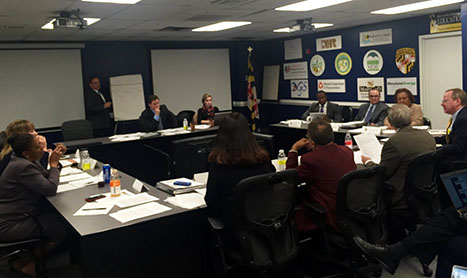ANNAPOLIS — The Maryland Redistricting Reform Commission met Tuesday to craft recommendations for ways to fix gerrymandering in Maryland, focusing on establishing an independent group to redistrict both congressional and legislative districts.
The commission wrote intricate rules to limit partisan influence and ensure independence of the new panel, and is requiring it to apply state law to congressional redistricting.
When drawing congressional boundaries in the current system, Maryland’s governor leads the process, which follows a more general federal standard. These rules mandate that districts must be drawn with equal populations and in compliance with the Voting Rights Act, which prohibits racial discrimination in the voting process.
But under Maryland law, when drawing state legislative boundaries, districts must be contiguous and compact, “with due regard for natural boundaries and the boundaries of political subdivisions”.
In the past, minority lawmakers and political groups have complained that minority populations are split up and grouped together to help keep incumbent Democrats in power.
The commission held five public regional meetings in different parts of Maryland, hearing from legislators and residents about their ideas on how to reform voting districts.
Hogan in August signed an executive order creating the commission to address gerrymandering in both legislative and congressional voting districts.
“Maryland is home to some of the most gerrymandered districts in the country, a distinction that we should not be proud of,” Gov. Larry Hogan, a Republican, said in a statement Aug. 6. “My administration’s goal is to reform this process and put Maryland’s redistricting process on a new path toward transparency, fair representation, and election integrity.”
Commission member Delegate Jason Buckel, R-Allegany, said during an Oct. 20 commission meeting that it is “pretty apparent that the status quo is unacceptable.”
To form the new, nine-member independent group, the commission is recommending that one judge from the Court of Special Appeals of Maryland and two from the Maryland Circuit Courts will be chosen at random to select the members of the group.
To apply to serve as member of this independent group, applicants must have been a Maryland resident for the past five years, they cannot have switched party lines in the past five years and they cannot have run for legislative or congressional office in the past five years.
The judges will choose 30 people — 10 Democrats, 10 Republicans and 10 independents from the pool of applicants — to possibly serve on the work group.
From those 30, nine individuals will be randomly chosen, with three from each political affiliation, to become members of the independent redistricting panel.
Sen. Joan Carter Conway, a member of the redistricting commission, said that focusing on the concept of creating an independent group to redistrict Maryland is improbable, as too many legislative stakeholders have an impact, such as the governor’s role of appointing judges.
Members of an “independent redistricting commission are as far from independent as the legislators are,” said Conway, D-Baltimore City.
Conway also said that the commission should do something to fix congressional districts but avoid the legislative districts.
In Maryland, redistricting occurs every 10 years following the results of the U.S. census. In 2012, Gov. Martin O’Malley, D, redrew the 6th congressional district, taking away conservative votes in order to oust a veteran Republican.
Registered Democrats outweigh registered Republicans in Maryland more than 2-to-1, according to eligible active voter data from the 2014 gubernatorial election.
Seven of the state’s eight seats in the U.S. House of Representatives are held by Democrats.
When redistricting, according to Maryland’s constitution, the governor is required to hold public hearings to create a legislative district plan. The governor’s plan automatically takes effect 45 days into the legislative session unless the General Assembly drafts its own plan.
The Maryland constitution requires 47 legislative districts, with one senator and three delegates from each. It also requires that the districts must have roughly equal population, compact and contiguous.
Elbridge James of the NAACP said that voting districts in Maryland disenfranchise people of color because they lack equal representation.
“If the governor does not get it right, he does a disservice and disadvantage to all of our communities,” James said. “I need to have voices heard and redistricting allows voices to be heard.”
Senator Anthony Muse, D-Prince George’s, called past redistricting purely gerrymandering where the district maps did not accurately represent the people in their jurisdiction and said that there was not enough minority representation at both the congressional and legislative level.
The commission must submit a report to the governor, Senate President Thomas V. Mike Miller Jr., D-Calvert, Charles and Prince George’s, and House Speaker Michael Busch, D-Anne Arundel, by Nov. 3., and is slated to be formally disbanded on Nov. 8, 2016.

